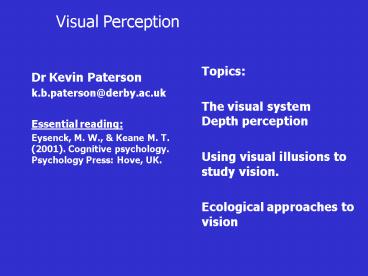Dr Kevin Paterson - PowerPoint PPT Presentation
1 / 13
Title:
Dr Kevin Paterson
Description:
The visual system. Depth perception. Using visual illusions to study vision. ... Visual illusions - what they tell us about perception. Visual Perception ... – PowerPoint PPT presentation
Number of Views:126
Avg rating:3.0/5.0
Title: Dr Kevin Paterson
1
- Topics
- The visual systemDepth perception
- Using visual illusions to study vision.
- Ecological approaches to vision
- Dr Kevin Paterson
- k.b.paterson_at_derby.ac.uk
- Essential reading
- Eysenck, M. W., Keane M. T. (2001). Cognitive
psychology. Psychology Press Hove, UK.
2
- FUNCTION OF EYE
- Light is reflected from surface of objects. It
passes through pupil lens before landing on
retina at the back of the eye. - The optic nerve passes neural data to the
mid-brain. This passes information onto the
visual cortex. - Visual data is processed at the retina, by areas
of the mid-brain, and regions of the visual
cortex.
3
- BOTTOM-UP TOP-DOWN PROCESSES
- Major debate is vision predominantly a bottom-up
or top-down process? - Bottom-up sensory information is processed in
terms of basic features, features are combined to
form objects, and objects are recognised.
Perceiver reconstructs objects in world. - Top-down perceiver uses knowledge and
expectations to impose interpretation on incoming
sensory data. Perceiver hypothesises about
objects in world.
4
LIGHT
- RETINAL STRUCTURES
- Light passes through neural layers strikes
receptors (rods cones). Cones concentrate in
fovea, none in perifovea. - Neural signal passes to bipolar cells then
ganglion cells. - Ganglion cells specialised for detection of
particular patterns of light falling on the
retina.
5
- VISUAL PATHWAYS
- Neural pathways take information from retina to
Lateral Geniculate Nuclei (LGN) to visual cortex. - Optic nerve for each eye splits with half going
to right side of brain and half to left side of
brain. - Pathways Parvocellular involved in colour vision
focal attention. Magnocellular involved in
non-colour vision and global attention.
6
- VISUAL CORTEX
- Neurons within the visual cortex as specialised
for feature detection, lines of particular
orientation. - P- and M-pathways extend into the visual cortex.
- Parvocellular neurons are specialised for
processing of detailed visual information. - Magnocellular neurons are specialised for
processing of novel or moving stimuli.
7
- Visual illusions - what they tell us about
perception
8
- Visual illusions - what they tell us about
perception
9
- Optic flow
10
- Motion parallax
11
- Muller-Lyer illusion
12
- Muller-Lyer illusion
13
- Motion parallax





























![[PDF] DOWNLOAD Kevin Smith's Secret Stash: The Definitive Visual Histo PowerPoint PPT Presentation](https://s3.amazonaws.com/images.powershow.com/10070443.th0.jpg?_=202407020211)

